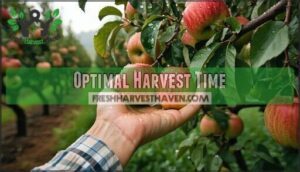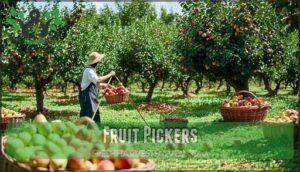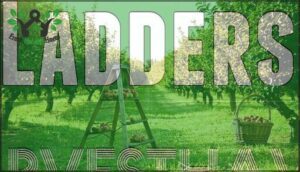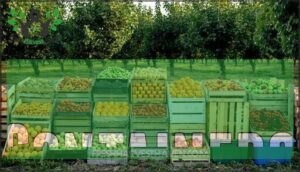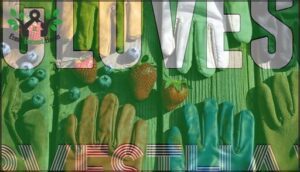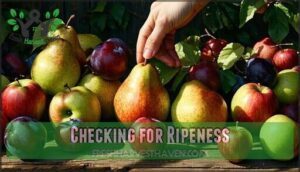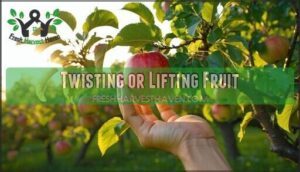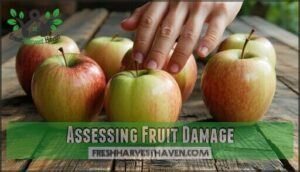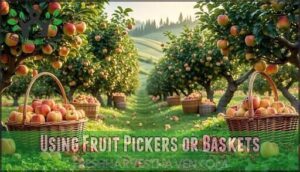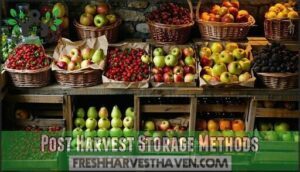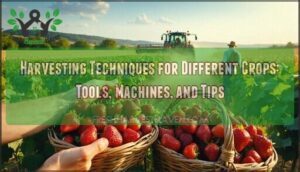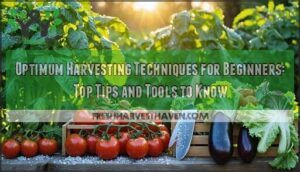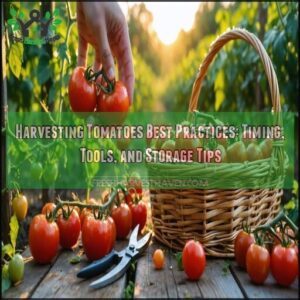This site is supported by our readers. We may earn a commission, at no cost to you, if you purchase through links.
 You’ll master proper fruit harvesting methods to prevent damage by timing your picks when fruit releases easily from branches and using gentle, upward twisting motions rather than pulling.
You’ll master proper fruit harvesting methods to prevent damage by timing your picks when fruit releases easily from branches and using gentle, upward twisting motions rather than pulling.
Soft fruits like peaches need padded baskets and careful handling—think of them as nature’s stress balls that bruise if you look at them wrong.
Hard fruits such as apples can tolerate slightly firmer grips but still require respect.
Use fruit pickers for high branches and shallow containers to prevent crushing bottom layers.
Check each piece for ripeness indicators like color changes and slight give when pressed.
The secret lies in understanding each variety’s unique harvesting personality.
Table Of Contents
- Key Takeaways
- Harvesting Fruit Types
- Optimal Harvest Time
- Essential Harvest Tools
- Handling Fruit Carefully
- Post Harvest Storage Methods
- Frequently Asked Questions (FAQs)
- How can harvesting improve the quality of fruits?
- How do you handle fruits & vegetables during harvesting?
- How do you maintain fruit quality after harvesting?
- How to keep fruits fresh after harvest?
- What are some effective harvesting practices?
- What are the good harvesting practices?
- What are the 4 methods of harvesting PPT?
- What are the preventive methods for post-harvest losses?
- What are the three most common harvesting methods?
- What should you do to avoid damages during harvesting?
- Conclusion
Key Takeaways
- You’ll prevent fruit damage by timing your harvest correctly—look for full color development, easy stem separation, and slight softness when pressed, then pick during cool morning hours when fruits are well-hydrated but surface moisture has evaporated.
- You should use gentle upward twisting motions instead of pulling fruit from branches, cupping each piece in your palm while supporting the branch with your free hand to prevent both fruit bruising and tree damage.
- You need the right tools for damage-free harvesting—use padded baskets for soft fruits, shallow containers to prevent crushing bottom layers, telescoping fruit pickers for high branches, and sharp pruning shears for clean cuts.
- You must handle different fruit varieties according to their specific needs—treat soft fruits like peaches as delicate stress balls requiring extra cushioning, while harder fruits like apples can tolerate firmer grips but still demand respectful handling throughout the harvest process.
Harvesting Fruit Types
Each fruit tree type requires specific harvesting techniques to prevent damage and maximize quality.
You’ll need to adjust your approach based on whether you’re working with deciduous, evergreen, dwarf, or tropical varieties since their growth patterns and fruit characteristics vary substantially, considering complete concepts.
Deciduous Fruit Trees
Successfully harvesting deciduous fruit trees requires understanding their seasonal cycles and gentle handling techniques.
These trees shed leaves annually, making their dormancy period vital for planning your harvest strategy.
Follow these essential steps for damage-free harvesting:
- Time your fall harvest perfectly by checking for full color development and easy fruit detachment
- Use gentle twisting motions rather than pulling to prevent bruising and branch damage
- Thin clusters early during spring budding to prevent branch breakage and guarantee larger, healthier fruits
Master these fruit handling techniques and you’ll protect your investment while maximizing yield from your deciduous fruit trees.
Evergreen Fruit Trees
Evergreen fruit trees’ year-round foliage demands specialized harvesting approaches for citrus, olives, and avocados.
Year-round harvests require year-round expertise—evergreen trees never rest, and neither should your harvesting skills.
Proper pruning techniques enhance airflow while supporting effective pest management strategies. These evergreen varieties thrive under specific soil requirements and climate considerations that influence harvest timing.
When picking, you’ll prevent fruit damage prevention by checking for full color development and easy detachment.
Use gentle fruit handling methods during fruit harvesting to guarantee bruise prevention. Cup each fruit in your palm and twist gently rather than pulling to maintain quality throughout your evergreen fruit trees harvest.
Dwarf Fruit Trees
Dwarf varieties bring orchards down to eye level, making fruit harvesting a breeze. These space-efficient trees pack full-sized flavor into compact forms through careful rootstock selection, perfect for container gardening enthusiasts.
Your dwarf fruit trees need strategic care for damage-free harvests:
- Regular pruning techniques maintain airflow and manageable size
- Strategic fruit thinning prevents branch breakage from heavy loads
- Gentle handling during picking preserves fruit quality
- Proper timing guarantees peak ripeness without over-maturity
When harvesting, cup each fruit and twist gently—never yank or pull. This picking technique protects both your harvest and the tree’s delicate branches for future seasons. To promote healthy growth, consider that dwarf fruit trees need full sun exposure.
Tropical Fruit Trees
When tropical fruit trees reach peak ripeness, exotic varieties like mangoes, papayas, and guavas demand careful attention to prevent fruit bruising.
Climate impact affects timing, so you’ll need to adjust your fruit harvesting schedule accordingly. Use gentle fruit handling techniques with soft twisting motions rather than yanking—your fruits will thank you for it.
Long-handled fruit pickers work wonders for tall trees, keeping you grounded while reaching high branches.
Regular tropical pruning improves airflow and makes harvesting easier, while fruit thinning guarantees larger, healthier fruits.
Most tropical fruits signal ripeness through color changes and gentle softness, making fruit damage prevention achievable with proper pest control and soil health maintenance.
Optimal Harvest Time
When should you harvest fruit for maximum flavor and minimal damage? The answer lies in understanding ripeness indicators and timing your approach perfectly.
Peak maturity occurs when fruits exhibit specific signs: background color changes from green to their characteristic hue, easy separation from branches, and a sweet, distinctive aroma.
Weather impact plays a vital role—harvest during cool, dry mornings when fruits are well-hydrated but free from moisture that could promote rot.
Key timing factors include:
- Seasonal variations affect ripeness schedules across different climates
- Harvesting frequency should increase as peak season approaches
- Most fruits reach prime fruit ripeness just before full tree maturity
Smart harvesting techniques focus on proper timing rather than waiting for overripeness, ensuring better fruit handling and reduced fruit damage.
It’s also necessary to review fruit harvest timing to maximize flavor.
Essential Harvest Tools
You’ll need the right tools to harvest fruit without causing damage that reduces quality and storage life.
Proper equipment like fruit pickers, ladders, containers, pruning shears, and gloves guarantees you can gather your harvest efficiently while protecting both the fruit and yourself, using the right tools is essential for a successful harvest with proper equipment.
Fruit Pickers
Selecting the right fruit pickers transforms your harvest from a wrestling match into a graceful dance. Quality fruit pickers feature telescoping poles that extend your reach without compromising stability. The key lies in choosing tools with soft catchers – gentle basket designs that cradle each piece of fruit like precious cargo.
Professional picker types vary by fruit size and tree height. Damage prevention starts with understanding which tool matches your specific harvest needs.
| Picker Type | Best For | Key Feature |
|---|---|---|
| Basket Pickers | Apples, pears | Padded collection bags |
| Pole Pickers | High branches | Adjustable telescoping reach |
| Net Catchers | Delicate fruits | Ultra-soft catching surface |
| Claw Pickers | Small fruits | Precision gripping mechanism |
Proper picking techniques using these fruit harvesting tools eliminate the need for risky ladder climbing. Consider using specialized harvest shears for delicate tasks. Your harvesting techniques improve dramatically when you match the right picker to each fruit type, ensuring fruit damage prevention techniques work effectively throughout your orchard.
Ladders
Beyond fruit pickers, sturdy ladders become your pathway to perfectly ripe fruit hanging just out of reach. A tripod orchard ladder offers superior stability compared to traditional extension ladders on uneven orchard terrain. Choose models with comfortable rung spacing – typically 12 inches apart – to prevent fatigue during extended harvesting sessions. Many retailers offer a variety of models.
- Position the tripod pole uphill when working on slopes for maximum stability
- Make certain all three supports sink slightly into soft ground, never on rock or pavement
- Maintain three points of contact while climbing and always face the ladder
Proper ladder positioning prevents both fruit damage and personal injury. The three-leg design adapts naturally to irregular ground surfaces. Before each use, inspect ladder maintenance needs like loose bolts or damaged rungs. Consider ladder alternatives like picking poles for extremely tall trees when ladder safety becomes questionable.
Containers
Once your ladder’s secure, proper fruit containers make the difference between pristine produce and bruised disappointments.
Your harvest boxes need strategic planning to prevent fruit damage prevention failures.
- Container Materials: Plastic crates handle wet conditions while wooden harvest boxes offer durability and ventilation
- Size Matters: Smaller containers prevent crushing—heavy apples need shallow bins to protect bottom layers
- Padding Options: Cushioned liners create gentle fruit handling for delicate berries and stone fruits
Choose stackable designs with handles for easy transport.
Selecting the right equipment guarantees efficient fruit collection and transport.
Cleaning protocols between harvests prevent contamination and extend your produce’s shelf life.
Pruning Shears
After gathering your harvest in proper containers, you’ll need pruning shears that cut cleanly without bruising delicate fruit stems. Sharp blade maintenance prevents the crushing that leads to fruit damage prevention failures—wipe blades with rubbing alcohol after each use and sharpen them monthly.
Proper shear sizing matters more than you’d think. Oversized tools cause hand fatigue, while undersized ones won’t handle thicker stems.
Bypass models work like scissors, making clean cuts that heal quickly. Anvil types crush stems against a flat surface, creating entry points for rot.
Ergonomic design features like cushioned grips and spring-loaded handles reduce strain during long harvest sessions. Cutting techniques should involve positioning blades perpendicular to stems, then making swift, confident cuts.
Quality shear types with safety locks and replaceable blades justify their higher cost through years of reliable performance.
Gloves
The right gloves transform your harvesting experience from painful to productive.
Cotton gloves provide the perfect balance between protection and dexterity, while leather options offer superior thorn protection for thorny fruit varieties.
Glove fit matters more than you think.
Loose gloves slip during critical moments, while tight ones restrict blood flow and reduce sensitivity.
Test your grip enhancement by picking up a coin – if you can’t manage it easily, try a different size.
Glove materials like nitrile-coated cotton give you the best of both worlds: durability and feel.
These materials resist punctures while maintaining tactile feedback for gentle fruit handling.
Glove hygiene prevents contamination between different fruit types.
Keep multiple pairs handy and wash them regularly.
Quality glove durability means they’ll last through multiple seasons, making the initial glove cost worthwhile.
Proper glove sizing guarantees comfort during long harvest sessions.
Handling Fruit Carefully
Proper handling during harvest determines whether your fruit reaches the table unblemished or ends up as expensive compost.
You’ll prevent costly bruising and damage by using gentle twisting motions, cupping each piece in your palm, and never pulling fruit directly from branches, which helps in preventing damage.
Checking for Ripeness
Once you’ve gathered your tools, determining peak ripeness becomes your next challenge.
Ripeness mastery separates weekend gardeners from harvest professionals who consistently pick perfect fruit.
Smart harvesters know that checking for ripeness separates amateur pickers from experienced ones.
Your fruit’s readiness depends on multiple ripeness indicators working together.
Here’s how to spot peak ripeness every time:
- Color Development – Watch for uniform, vibrant hues that signal maturity.
- Fruit Firmness – Press gently with your thumb.
- Aroma Indicators – Cup the fruit near your nose.
- Weight Test – Mature fruit feels heavier than expected due to concentrated juices and developed flesh.
Apples shift from green to deep red, while pears develop yellow-green tones with subtle color changes indicating sugar content peaks.
Ripe fruit yields slightly without denting, showing the perfect balance between firmness and softness.
Sweet, distinctive scents reveal ideal sugar content and seed maturity.
Trust these signals together rather than relying on just fruit color or fruit softness alone.
Twisting or Lifting Fruit
Once you’ve confirmed your fruit shows proper ripe indicators, it’s time to master gentle detachment techniques. Think of removing fruit like unscrewing a jar lid – apply steady, controlled pressure with a gentle upward twist.
Cup the fruit in your palm while supporting the branch with your free hand. This dual approach prevents branch damage and maintains stem integrity during removal. Rotate the fruit slowly until it releases naturally at the connection point. Never yank or pull forcefully, as this compromises both fruit quality and tree health.
Professional orchardists follow three key principles for successful fruit detachment:
- Support the branch to prevent stress fractures and future productivity loss
- Use gentle handling techniques that preserve the fruit’s natural protective barriers
- Stop immediately if you feel resistance – unripe fruit won’t detach easily.
Remember, proper twisting or lifting fruit techniques prevent bruising and extend storage life substantially. A clean separation with the stem attached indicates you’ve mastered this fundamental skill.
Assessing Fruit Damage
After mastering proper twisting and lifting techniques, you’ll need sharp eyes for spotting trouble before it ruins your entire harvest.
Damage symptoms often hide in plain sight, waiting to spread throughout your carefully picked fruit.
Smart fruit evaluation protects your investment through systematic inspection. Here’s your damage assessment checklist:
- Surface inspection – Look for bruises, cuts, punctures, and sunburn marks that compromise fruit integrity
- Gentle pressure testing – Squeeze lightly to detect soft spots indicating internal rot or Impact Severity issues
- Stem junction examination – Check attachment points where decay-causing organisms typically enter
- Color pattern analysis – Identify unusual discoloration that signals pest damage or Quality Degradation
- Scent evaluation – Trust your nose to detect off-odors revealing hidden problems
Morning light reveals even subtle defects better than midday glare.
Bruise Identification becomes second nature with practice, helping prevent harvest-ruining problems through early Rot Prevention and proper Damage Extent assessment.
Using Fruit Pickers or Baskets
Once you’ve spotted damaged fruit, selecting proper fruit picking equipment becomes your next priority.
The right basket types and telescoping handles can make or break your harvest quality.
Smart tool selection prevents picker damage before it starts:
- Telescopic fruit pickers with soft padding extend your reach up to 20 feet, eliminating dangerous ladder work
- Padded collection baskets featuring foam linings cushion falling fruit, ensuring bruising prevention during impact
- Small hand baskets with ventilated designs work perfectly for delicate berries and stone fruits
- Bucket-style pickers equipped with cloth bottoms gently catch fruit while you twist and release from branches
- Mesh collection bags promote air circulation, keeping freshly harvested fruit cool and preventing moisture buildup
Consider capacity considerations when choosing containers. Overfilled baskets create pressure points that damage fruit at the bottom.
Knowing the ideal harvest timing can also minimize damage.
Gentle fruit handling starts with proper fruit basket design that matches your orchard’s specific needs and reach limitations.
Post Harvest Storage Methods
Once you’ve carefully harvested your fruit, proper storage becomes the key factor that determines how long your harvest stays fresh and maintains its quality.
You’ll need to match each fruit type with its specific temperature, humidity, and storage requirements to prevent spoilage and extend shelf life.
Refrigeration Storage
Once you’ve wrapped up your careful harvest, refrigeration storage locks in peak freshness. Your cooling rates matter—get fruits to 32-38°F within hours to prevent deterioration. Temperature fluctuations spell disaster, so maintain consistent conditions.
| Fruit Type | Temperature (°F) | Humidity Level |
|---|---|---|
| Apples | 30-32 | 90-95% |
| Berries | 32-36 | 90-95% |
| Stone Fruits | 31-32 | 90-95% |
| Citrus | 32-36 | 85-90% |
| Tropical | 50-55 | 85-90% |
Air circulation prevents hot spots while humidity levels at 85-95% stop moisture loss. Smart energy efficiency comes from proper loading—don’t overcrowd. This proper fruit harvesting methods approach guarantees your fruit storage investment pays off through extended shelf life.
Freezing Storage
Beyond refrigeration, freezing storage transforms your harvest into a time capsule that preserves fruit quality for months. This fruit preservation method stops deterioration completely when done right.
Master freezing storage with these essential steps:
- Blanch fruits briefly – prevents enzyme damage and maintains color
- Flash freeze individually – stops clumping and freezer burn
- Choose proper packaging options – vacuum-sealed bags work best
- Plan thawing methods – gradual defrosting prevents fruit damage
Freezing duration varies by fruit type, but most maintain quality for 8-12 months. For extended storage, consider vacuum sealing fruit to prevent freezer burn.
Room Temperature Storage
Storage-savvy fruit enthusiasts understand that room temperature storage offers the perfect solution for many varieties when properly managed. You’ll maintain ideal flavor and texture by keeping bananas, avocados, citrus fruits, and tomatoes on your counter rather than chilling them.
Successful ambient conditions require strategic planning:
- Choose cool, dark locations away from direct sunlight to prevent accelerated ripening stages
- Use storage containers with excellent ventilation to minimize fruit spoilage from moisture buildup
- Separate ethylene-producing fruits like apples from sensitive varieties to reduce fruit damage
- Arrange different fruit varieties in single layers to prevent bruising during fruit handling
Wooden crates or slatted baskets serve as ideal storage containers since they promote air circulation. Check your room temperature storage daily for ripeness changes—this simple inspection extends shelf life while preserving quality. The best duration varies by fruit type, but most varieties stay fresh for several days when you follow these guidelines.
Humidity Control
Getting the humidity right transforms your storage from a fruit graveyard into a preservation paradise. While room temperature matters, humidity control determines whether your harvest stays crisp or turns mushy.
Storage humidity directly impacts fruit quality preservation through ripening effects and condensation prevention. Too much moisture creates a breeding ground for mold, while too little leaves your fruit wrinkled and sad.
Optimal levels vary by fruit type:
- Berries and leafy greens need high humidity (90-95%) to prevent wilting
- Citrus fruits prefer moderate levels (65-70%) to avoid skin breakdown
- Apples require consistent moisture (85-90%) for extended storage
- Root vegetables thrive in humid conditions (90-95%) maintaining texture
- Stone fruits need balanced humidity (80-85%) preventing fruit damage
Humidity sensors help you monitor conditions accurately. Use perforated bags for postharvest handling that balances moisture without trapping excess. Proper fruit handling includes avoiding overcrowding—good airflow prevents condensation buildup that leads to rapid deterioration.
Regular Fruit Inspection
Proper humidity sets the stage, but regular fruit inspection becomes your quality control checkpoint. Check stored fruit every 1-2 days, gently handling each piece to detect ripeness indicators like softness changes or color shifts. Good lighting helps spot early damage prevention opportunities before problems spread.
Watch for pest detection signs during each inspection – small holes or unusual marks signal trouble. Remove damaged pieces immediately to prevent harvestruining problems from spreading to healthy fruit.
Sort by ripeness level in separate containers for better quality control. This simple harvest adjustments strategy maximizes storage life while ensuring you’re always enjoying fruit at peak condition.
Frequently Asked Questions (FAQs)
How can harvesting improve the quality of fruits?
You’ll dramatically boost fruit quality by harvesting at peak ripeness, using gentle twisting motions instead of pulling, and picking during cool morning hours when fruits are well-hydrated but dry.
How do you handle fruits & vegetables during harvesting?
Handle fruits and vegetables like precious cargo during harvest.
Use gentle twisting motions instead of pulling, cup delicate produce in your palm.
Harvest when they’re cool but dry to prevent bruising and damage.
How do you maintain fruit quality after harvesting?
About 40% of harvested produce spoils before reaching consumers.
You’ll preserve fruit quality by cooling immediately, handling gently, maintaining proper humidity, inspecting regularly for damage, and storing at ideal temperatures specific to each fruit type.
How to keep fruits fresh after harvest?
Cool harvested fruits immediately using cold water or refrigeration.
Store at suitable temperatures between -1°C to 13°C depending on fruit type.
Maintain proper humidity levels, guarantee good air circulation, and remove damaged fruits promptly.
What are some effective harvesting practices?
The early bird catches the worm when you harvest in cool morning hours.
Twist fruits gently rather than pulling, check for proper ripeness, and handle produce like precious cargo to prevent bruising and maximize quality.
What are the good harvesting practices?
Twist fruits gently rather than pulling to avoid bruising.
Pick during cool morning hours after dew dries.
Check for proper ripeness through color and firmness.
Use sharp, clean tools and handle produce carefully throughout the process.
What are the 4 methods of harvesting PPT?
Manual picking involves hand-harvesting ripe fruits using gentle twisting motions.
Mechanical harvesting uses specialized equipment for efficiency.
Semi-mechanical combines tools with hand labor.
Selective harvesting targets only mature fruits for superior quality.
What are the preventive methods for post-harvest losses?
You might think post-harvest losses are inevitable, but they’re not.
Use gentle handling techniques, maintain proper temperatures, remove damaged produce quickly, sanitize equipment regularly, and choose appropriate packaging to preserve your harvest’s quality and value.
What are the three most common harvesting methods?
You’ll find success using hand-picking for delicate fruits, mechanical harvesting for large-scale operations, and selective picking for gradual ripening. Each method suits different crops and farm sizes perfectly.
What should you do to avoid damages during harvesting?
Like knights of old wielding gentle swords, you’ll harvest with care by using soft twisting motions.
Picking during cool morning hours, handling fruit gently, and keeping tools sharp to prevent bruising and damage.
Conclusion
Patience pays dividends in the context of fruit harvesting success.
You’ve learned that proper fruit harvesting methods to prevent damage require understanding ripeness indicators, using appropriate tools, and handling techniques suited to each variety.
Remember that gentle twisting motions work better than pulling, padded containers protect delicate fruits, and timing matters more than speed.
Master these fundamentals and you’ll consistently harvest premium fruit while minimizing waste.
Your trees and taste buds will thank you for the careful attention.
- https://www.ncat.edu/caes/cooperative-extension/small-scale-agriculture-development/produce-safety/post-harvest-losses.php
- https://content.ces.ncsu.edu/introduction-to-the-postharvest-engineering-for-fresh-fruits-and-vegetables/8-harvesting-and-handling-fresh-produce
- https://blog-fruit-vegetable-ipm.extension.umn.edu/2022/09/harvesting-and-using-fallen-apples-and.html
- https://ptes.org/campaigns/traditional-orchard-project/orchard-practical-guides/fruit-harvest/
- https://aggie-horticulture.tamu.edu/vegetable/guides/texas-vegetable-growers-handbook/chapter-x-harvesting-handling/

